
This task requires students to apply the Pythagorean Theorem.
- Subject:
- Math
- Material Type:
- Activity/Lab
- Provider:
- Illustrative Mathematics
- Provider Set:
- Illustrative Mathematics
- Author:
- Illustrative Mathematics
- Date Added:
- 05/01/2012

This task requires students to apply the Pythagorean Theorem.

Students learn the importance of the Pythagorean theorem as applied in radar imaging. They use a sensor unit with IRED (infrared emitting diode) to measure triangle distances and the theorem to calculate and verify distances. Student groups calibrate the sensor units to ensure accurate distance measurements. A "pretend" outdoor radar imaging model is provided to groups for sensor unit testing.

This task is for instruction purposes. Part (b) is subtle and the solution presented here uses a "dynamic" view of triangles with two side lengths fixed. This helps pave the way toward what students will see later in trigonometry but some guidance will likely be needed in order to get students started on this path.
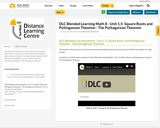
The purpose of this lesson is to use what has been learned about squares and square roots to find the side lengths of a right triangle.
Included is a YouTube video to support Grade 8 Blended Learning Math - Unit 1.5: Square Roots and Pythagorean Theorem - The Pythagorean Theorem.
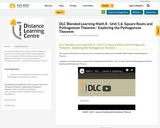
The purpose of this lesson is to look at various triangles and explore how to identify right triangles using Pythagorean Theorem.
Included is a YouTube video to support Grade 8 Blended Learning Math - Unit 1.6: Square Roots and Pythagorean Theorem - Exploring the Pythagorean Theorem.
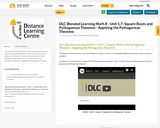
The purpose of this lesson is to use the Pythagorean Theorem and its corresponding algebraic expression solve a variety of problems.
Included is a YouTube video to support Grade 8 Blended Learning Math - Unit 1.7: Square Roots and Pythagorean Theorem - Applying the Pythagorean Theorem.
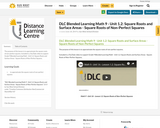
The purpose of this lesson is to approximate the square roots of non-perfect squares.
Included is a YouTube video to support Grade 9 Blended Learning Math - Unit 1.2: Square Roots and Surface Areas - Square Roots of Non-Perfect Squares.
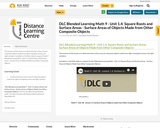
The purpose of this lesson is to determine the surface area of composite objects made from right rectangular prisms and right cylinders.
Included is a YouTube video to support Grade 9 Blended Learning Math - Unit 1.4: Square Roots and Surface Areas - Surface Areas of Objects Made from Other Composite Objects.

The purpose of this lesson is to discover the relationship between a radius and a tangent, then solve related problems.
Included is a YouTube video to support Grade 9 Blended Learning Math - Unit 8.1: Circle Geometry - Properties of Tangents to a Circle.
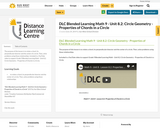
The purpose of this lesson is to relate a chord, its perpendicular bisector and the center of a circle. Then, solve problems using these relationships.
Included is a YouTube video to support Grade 9 Blended Learning Math - Unit 8.2: Circle Geometry - Properties of Chords in a Circle.

Students use simple materials to design an open spectrograph so they can calculate the angle light is bent when it passes through a holographic diffraction grating. A holographic diffraction grating acts like a prism, showing the visual components of light. After finding the desired angles, students use what they have learned to design their own spectrograph enclosure.
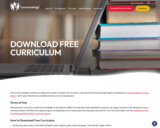
"The Core Knowledge Foundation provides open access to content-rich curriculum materials for preschool through grade 8, including the Core Knowledge Curriculum Series™, with many materials now available and many more in development."
You will need to provide your email address to download these amazing resources. CK has aligned their ELA to the Science of Reading in collaboration with Amplify Reading.
*Full Units
*Books for Students
*Teaching Materials
*Scope & Sequence

In this module, students learn about translations, reflections, and rotations in the plane and, more importantly, how to use them to precisely define the concept of congruence. Throughout Topic A, on the definitions and properties of the basic rigid motions, students verify experimentally their basic properties and, when feasible, deepen their understanding of these properties using reasoning. All the lessons of Topic B demonstrate to students the ability to sequence various combinations of rigid motions while maintaining the basic properties of individual rigid motions. Students learn that congruence is just a sequence of basic rigid motions in Topic C, and Topic D begins the learning of Pythagorean Theorem.
Find the rest of the EngageNY Mathematics resources at https://archive.org/details/engageny-mathematics.

In Module 3, students learn about dilation and similarity and apply that knowledge to a proof of the Pythagorean Theorem based on the Angle-Angle criterion for similar triangles. The module begins with the definition of dilation, properties of dilations, and compositions of dilations. One overarching goal of this module is to replace the common idea of same shape, different sizes with a definition of similarity that can be applied to geometric shapes that are not polygons, such as ellipses and circles.
Find the rest of the EngageNY Mathematics resources at https://archive.org/details/engageny-mathematics.

Module 7 begins with work related to the Pythagorean Theorem and right triangles. Before the lessons of this module are presented to students, it is important that the lessons in Modules 2 and 3 related to the Pythagorean Theorem are taught (M2: Lessons 15 and 16, M3: Lessons 13 and 14). In Modules 2 and 3, students used the Pythagorean Theorem to determine the unknown length of a right triangle. In cases where the side length was an integer, students computed the length. When the side length was not an integer, students left the answer in the form of x2=c, where c was not a perfect square number. Those solutions are revisited and are the motivation for learning about square roots and irrational numbers in general.
Find the rest of the EngageNY Mathematics resources at https://archive.org/details/engageny-mathematics.

Students explore the concept of similar right triangles and how they apply to trigonometric ratios. Use this lesson as a refresher of what trig ratios are and how they work. In addition to trigonometry, students explore a clinometer app on an Android® or iOS® device and how it can be used to test the mathematics underpinning trigonometry. This prepares student for the associated activity, during which groups each put a clinometer through its paces to better understand trigonometry.
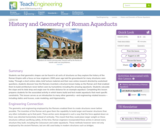
Students see that geometric shapes can be found in all sorts of structures as they explore the history of the Roman Empire with a focus on how engineers 2000 years ago laid the groundwork for many structures seen today. Through a short online video, brief lecture material and their own online research directed by worksheet questions, students discover how the Romans invented a structure known today as the Roman arch that enabled them to build architecture never before seen by humankind, including the amazing aqueducts. Students calculate the slope and its total drop and angle over its entire distance for an example aqueduct. Completing this lesson prepares students for the associated activity in which teams build and test model aqueducts that meet specific constraints. This lesson serves as an introduction to many other geometry—and engineering-related lessons—including statics and trusses, scale modeling, and trigonometry.

Sal introduces the famous and super important Pythagorean theorem! This lesson includes an introduction video followed by examples and practice problems involving finding the hypotenuse, finding a side, finding area of an isosceles triangle, and determining if a triangle is a right triangle. It is followed by a unit on Pythagorean theorem applications.
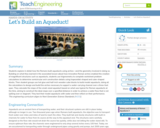
Students explore in detail how the Romans built aqueducts using arches—and the geometry involved in doing so. Building on what they learned in the associated lesson about how innovative Roman arches enabled the creation of magnificent structures such as aqueducts, students use trigonometry to complete worksheet problem calculations to determine semicircular arch construction details using trapezoidal-shaped and cube-shaped blocks. Then student groups use hot glue and half-inch wooden cube blocks to build model aqueducts, doing all the calculations to design and build the arches necessary to support a water-carrying channel over a three-foot span. They calculate the slope of the small-sized aqueduct based on what was typical for Roman aqueducts at the time, aiming to construct the ideal slope over a specified distance in order to achieve a water flow that is not spilling over or stagnant. They test their model aqueducts with water and then reflect on their performance.

Math Antics has amazing videos to explain concepts for Math. The videos are very clear and explicit and students love them. All of the video lessons are FREE.
There are also follow up exercises, videos and worksheets that students can use to solidify learning - but you will be required to pay $20 a year to access these. hat being said, it's super useful even without a paid account!
The videos are organized by strand, and all are free.
They cover numeracy, arithmetic, algorithms, fractions, mixed numbers, percentages, ratios, geometry, statistics, measurement, exponents, integers & algebra, algebra 1-3